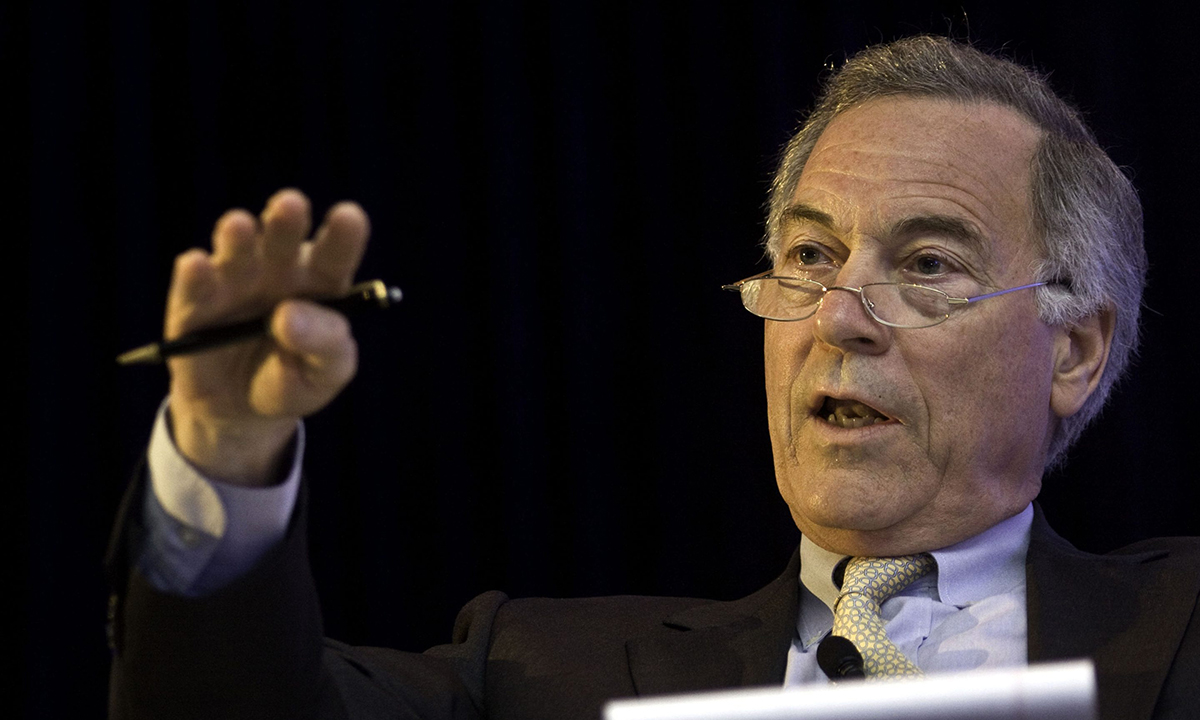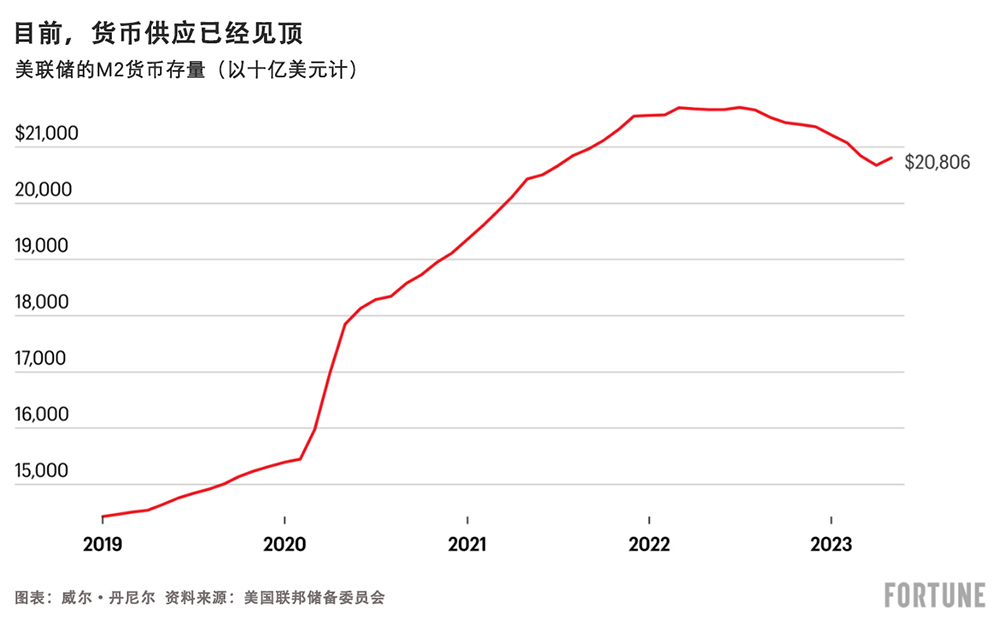“货币医生”称,忘掉“宣传”吧——通胀已经成为“历史”

在2023年的大部分时间里,经济学家们一直在对粘性通胀发出警告。
如今,一位被称为“货币医生”的著名学者对这一观点提出了质疑:“粘性”通货膨胀可能让美联储(Federal Reserve)在实现双重目标(确保价格稳定和实现充分就业)时面临严峻挑战。
“忘掉我们听到的所有宣传吧,比如美联储主席面临棘手问题,这将是一场旷日持久的斗争,事情很棘手等等。其实,事情并不是很棘手。”约翰斯·霍普金斯大学(Johns Hopkins University)的应用经济学教授史蒂夫·汉克于7月13日对美国消费者新闻与商业频道(CNBC)表示:“我认为通胀已经成为历史。”
成为货币医生之路
汉克在过去的几十年时间里为国家元首和财政部部长提供经济政策建议,因此获得了“货币医生”的称号。20世纪80年代,他曾经在美国总统罗纳德·里根的经济顾问委员会(Council of Economic Advisers)任职,并在20世纪90年代协助印度尼西亚总统苏哈托应对亚洲金融危机(Asian Financial Crisis)为该国带来的影响。汉克目前正在为阿根廷的自由党候选人哈维尔·米莱的助手提供建议(抗击该国严重通胀的最佳方案)。
这位教授是货币主义的支持者(货币主义是一种经济理论,认为货币供应量的变化是通货膨胀的主要驱动因素)。由于过去一年美国的货币供应不断萎缩,汉克认为通货膨胀不再是问题。这并不意味着消费者价格会下降(那将造成通货紧缩),但它确实标志着租金、食品和能源价格飙升时代的终结。
汉克说:“事实上,美国的货币供应量已经同比萎缩了4%。自1938年以来,我们从未见过这种情况。一切都与货币有关,因此[通胀下降]数据并不令我感到意外。”
汉克在7月13日继续指责媒体和他的经济学家同行们聚焦“通货膨胀的非货币原因”,例如供应链问题或企业利润率上升。“这简直是一派胡言。”他表示,并称自己刚刚完成了一项研究,将于今年9月发表。该研究显示,货币供应量的变化与通胀的变化之间存在一一对应的关系。
汉克指出,M2(广义货币供应量)指标(美联储追踪美国经济中的货币存量)在2020年2月新冠疫情开始到去年3月达到峰值期间,飙升了40%以上。在此期间,同比通胀率从2.3%跃升至8.5%。
然后,从去年7月到今年5月,货币供应量下降了近5%。年通胀率也随之从8.5%降至4%。

来自批发价格方面的证据
汉克表示,如果美联储继续缩减货币供应,通货膨胀就将很快达到“2%的目标范围”,他指出,批发价格的下降就是他提出的理论的证据。美国劳工统计局(Bureau of Labor Statistics)在7月13日公布的数据显示,6月衡量商品和服务生产商批发价格的生产者价格指数(PPI)仅较上年同期上涨0.1%,远低于2022年4月11.5%的峰值。
汉克称,在2021年通胀上升时,生产者价格指数领涨消费者价格指数(CPI),而核心通胀(不包括波动性较大的能源和食品价格)则落后于消费者价格指数。“现在,我们已经扭转了局面,生产者价格指数直线下降……消费者价格指数也直线下降。核心通胀已经远远落后了。”他说,并指出如果美联储继续缩减M2,“我们就将看到所有指数下降”。
汉克并不是唯一一位对通胀持乐观看法的人。LPL Financial的首席经济学家杰弗里·罗奇告诉《财富》杂志,最新的生产者价格指数的数据“对迫切希望看到通胀消退的投资者来说是另一个积极反馈”。
他补充道:“批发价格的下降,尤其是交通运输价格的下降,预示着在2023年的剩余时间里,经济活动放缓,消费价格进一步下降。”
尽管经济学家对2023年年初的通胀预测差异很大,而且他们对经济衰退的预测在过去几年中也差强人意,因此,关注汉克的理论可能是有意义的。今年2月,他预测通胀率将在2023年全年下降至2%至5%之间。随后,汉克解释道:“大约两个月前,我接受了《财富》杂志肖恩·塔利的采访,我说我认为通胀率可能会处于这个区间的下限范围内。现在看来确实如此。”
如果汉克的观点是正确的,那么2023年美国经济面临的真正问题就将不再是通胀,而是如何实现增长。(财富中文网)
译者:中慧言-王芳
在2023年的大部分时间里,经济学家们一直在对粘性通胀发出警告。
如今,一位被称为“货币医生”的著名学者对这一观点提出了质疑:“粘性”通货膨胀可能让美联储(Federal Reserve)在实现双重目标(确保价格稳定和实现充分就业)时面临严峻挑战。
“忘掉我们听到的所有宣传吧,比如美联储主席面临棘手问题,这将是一场旷日持久的斗争,事情很棘手等等。其实,事情并不是很棘手。”约翰斯·霍普金斯大学(Johns Hopkins University)的应用经济学教授史蒂夫·汉克于7月13日对美国消费者新闻与商业频道(CNBC)表示:“我认为通胀已经成为历史。”
成为货币医生之路
汉克在过去的几十年时间里为国家元首和财政部部长提供经济政策建议,因此获得了“货币医生”的称号。20世纪80年代,他曾经在美国总统罗纳德·里根的经济顾问委员会(Council of Economic Advisers)任职,并在20世纪90年代协助印度尼西亚总统苏哈托应对亚洲金融危机(Asian Financial Crisis)为该国带来的影响。汉克目前正在为阿根廷的自由党候选人哈维尔·米莱的助手提供建议(抗击该国严重通胀的最佳方案)。
这位教授是货币主义的支持者(货币主义是一种经济理论,认为货币供应量的变化是通货膨胀的主要驱动因素)。由于过去一年美国的货币供应不断萎缩,汉克认为通货膨胀不再是问题。这并不意味着消费者价格会下降(那将造成通货紧缩),但它确实标志着租金、食品和能源价格飙升时代的终结。
汉克说:“事实上,美国的货币供应量已经同比萎缩了4%。自1938年以来,我们从未见过这种情况。一切都与货币有关,因此[通胀下降]数据并不令我感到意外。”
汉克在7月13日继续指责媒体和他的经济学家同行们聚焦“通货膨胀的非货币原因”,例如供应链问题或企业利润率上升。“这简直是一派胡言。”他表示,并称自己刚刚完成了一项研究,将于今年9月发表。该研究显示,货币供应量的变化与通胀的变化之间存在一一对应的关系。
汉克指出,M2(广义货币供应量)指标(美联储追踪美国经济中的货币存量)在2020年2月新冠疫情开始到去年3月达到峰值期间,飙升了40%以上。在此期间,同比通胀率从2.3%跃升至8.5%。
然后,从去年7月到今年5月,货币供应量下降了近5%。年通胀率也随之从8.5%降至4%。
来自批发价格方面的证据
汉克表示,如果美联储继续缩减货币供应,通货膨胀就将很快达到“2%的目标范围”,他指出,批发价格的下降就是他提出的理论的证据。美国劳工统计局(Bureau of Labor Statistics)在7月13日公布的数据显示,6月衡量商品和服务生产商批发价格的生产者价格指数(PPI)仅较上年同期上涨0.1%,远低于2022年4月11.5%的峰值。
汉克称,在2021年通胀上升时,生产者价格指数领涨消费者价格指数(CPI),而核心通胀(不包括波动性较大的能源和食品价格)则落后于消费者价格指数。“现在,我们已经扭转了局面,生产者价格指数直线下降……消费者价格指数也直线下降。核心通胀已经远远落后了。”他说,并指出如果美联储继续缩减M2,“我们就将看到所有指数下降”。
汉克并不是唯一一位对通胀持乐观看法的人。LPL Financial的首席经济学家杰弗里·罗奇告诉《财富》杂志,最新的生产者价格指数的数据“对迫切希望看到通胀消退的投资者来说是另一个积极反馈”。
他补充道:“批发价格的下降,尤其是交通运输价格的下降,预示着在2023年的剩余时间里,经济活动放缓,消费价格进一步下降。”
尽管经济学家对2023年年初的通胀预测差异很大,而且他们对经济衰退的预测在过去几年中也差强人意,因此,关注汉克的理论可能是有意义的。今年2月,他预测通胀率将在2023年全年下降至2%至5%之间。随后,汉克解释道:“大约两个月前,我接受了《财富》杂志肖恩·塔利的采访,我说我认为通胀率可能会处于这个区间的下限范围内。现在看来确实如此。”
如果汉克的观点是正确的,那么2023年美国经济面临的真正问题就将不再是通胀,而是如何实现增长。(财富中文网)
译者:中慧言-王芳
Economists have been chanting warnings of the sticky inflation theory for most of 2023.
Now, a notable scholar known as the “money doctor” is challenging the idea that “sticky” inflation could make the Federal Reserve’s job of ensuring price stability and maximum employment for Americans a serious challenge.
“Forget all the propaganda we’re hearing — that the chairman of the Federal Reserve has a tough problem, that this is going to be a long fight, things are sticky and so forth. Things aren’t sticky,” Steve Hanke, a professor of applied economics at Johns Hopkins University, told CNBC on July 13. “I think the inflation story is history.”
Becoming the money doctor
Hanke earned his “money doctor” moniker after spending decades advising heads of state and finance ministers on economic policy. He served on President Reagan’s Council of Economic Advisers in the 80’s, and helped Indonesian President Suharto tackle the fallout from the Asian Financial Crisis in the 90’s. He’s currently consulting with aides to the Argentinian libertarian party candidate Javier Milei on the best ways to combat the nation’s rampant inflation.
The professor is a proponent of monetarism, an economic theory that holds that changes in the money supply are the main driver of inflation. With the money supply in the U.S. contracting over the past year, he believes inflation is no longer an issue. That doesn’t mean consumer prices are set to fall (that would be deflation), but it does signal the end of the era of surging rent, food, and energy prices.
“The fact that the money supply has been contracting on a year-over-year basis by 4% in the United States. We haven’t seen that since 1938,” Hanke said. “It’s all about money, so the [falling inflation] numbers don’t surprise me.”
Hanke went on to rebuke the press and his economist peers for focusing on “non-monetary causes of inflation”—like supply chain issues or rising corporate profit margins—on July 13. “This is utter rubbish,” he said, noting that he just finished a study, set to be published in September, which shows a one-to-one relationship between changes in the money supply and changes in inflation.
To Hanke’s point, the Federal Reserve’s M2 measure, which tracks the money stock in the U.S. economy, surged over 40% between February 2020 when the pandemic began and its peak in March of last year. During that period, year-over-year inflation jumped from 2.3% to 8.5%.
Then, between last July and this May, the money supply dropped nearly 5%. And year-over-year inflation again followed suit, falling from 8.5% to just 4%.
Evidence from wholesale prices
If the Fed continues to shrink the money supply, Hanke said inflation will hit the “2% range pretty fast,” pointing to falling wholesale prices as evidence for his theory. The producer price index (PPI), which measures wholesale prices for goods and services producers, rose just 0.1% from a year ago in June, the Bureau of Labor Statistics reported on July 13. That’s down from a peak of 11.5% in April of 2022.
Hanke noted that in 2021, when inflation was rising, the producer price index led the consumer price index higher, while core inflation, which excludes volatile energy and food prices, lagged behind. “Now, we’ve turned the thing around and the producer price indexes are falling like a stone….The consumer price index, it’s falling pretty much like a stone. And the core is lagging way behind,” he said, noting that “we’ll see all of that come down” if the Fed keeps shrinking M2.
Hanke isn’t alone in his more positive view of inflation. Jeffrey Roach, chief economist at LPL Financial, told Fortune that the latest PPI data was “another positive report for investors desperate to see inflation dissipate.”
“The decline in wholesale prices, especially for transporting freight, foreshadows a slowdown in both economic activity and a further deceleration in consumer prices throughout the balance of 2023,” he added.
While economist’s inflation predictions varied widely at the start of 2023, and their track record forecasting recessions hasn’t been the best over the past few years, it may make sense to pay attention to Hanke. In February, he predicted inflation would fall throughout 2023 to a range between 2% and 5%. Then, Hanke explained: “About two months ago I did an interview in Fortune Magazine, with Shawn Tully, and I said I think it’ll probably be at the lower end of that range. And it’s looking like it will be.”
If Hanke is right, the real issue for the U.S. economy in 2023 won’t be inflation, it will be growth.













